 W
WAidachar is an extinct genus of ichthyodectiform teleost ray-finned fish from the Late Cretaceous of Kyzyl Kum, central Asia. It was named by Lev Nesov in 1981. At first, he tentatively described the fossil material as the jaw fragments of a ctenochasmatid pterosaur, but reinterpreted Aidachar as a fish in 1986. The type species is A. paludalis.
 W
WAnaethalion is an extinct genus of prehistoric ray-finned fish.
 W
WAraripichthys is an extinct genus of prehistoric ray-finned fish that lived from the Aptian to Coniacian stages of the Cretaceous period. The genus is named after the Araripe Basin, where it was found in the Crato and Santana Formations. Other fossils of the genus have been found at Goulmima in Morocco, the Tlayua Formation of Mexico and the Apón Formation of Venezuela.
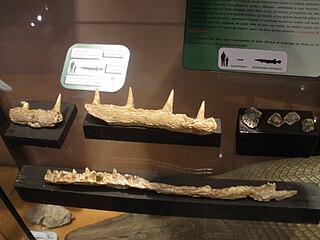 W
WAtractosteus africanus is a potentially dubious species of gar from the Cretaceous period of Niger and France. The species possibly lived until the end of the Cretaceous, during the Maastrichtian.
 W
WAxelrodichthys is an extinct genus of mawsoniid coelacanth from the Cretaceous of Africa, North and South America. Fossils of the genus have been found in the Crato Formation of Brazil, the Tlayua Formation of Mexico and the Ankazomihaboka Formation of Madagascar.
 W
WBerycopsis is an extinct genus of beardfish from the Cretaceous period. Fossils is known from England.
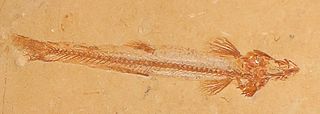 W
WCharitopsis is an extinct genus of prehistoric bony fish that lived during the lower Cenomanian.
 W
WChirothrix is an extinct genus of prehistoric ray-finned fish that lived during the Santonian.
 W
WCoccodontidae is a family of extinct pycnodontid fish that lived during the lower Cenomanian. The various genera had massive, curved spines.
 W
WCoccodus is an extinct genus of extinct pycnodontid fish that lived during the lower Cenomanian. The various species had a pair of massive, curved spines emanating from the lower sides of the head, and one curved spine on the top of its head. Unlike most pycnodontids, Coccodus species had a comparatively long body, giving the living animals a superficial resemblance to a scaly chimaera.
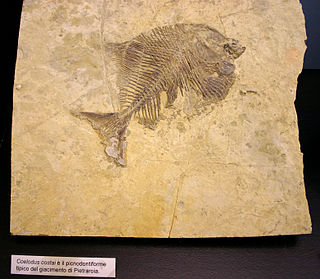 W
WCoelodus is an extinct genus of pycnodontiform fish from the Late Jurassic to early Paleocene (Danian). Fossils of the genus have been found in:JurassicGardies, FranceCretaceousYacoraite Formation, Argentina El Molino Formation, Bolivia Baharîje Formation, Egypt Ahlen and Bückeberg Formations, Germany Nimar Formation, India Alburni, Italy Damergou, Zinder, Niger Cochirleni Formation, Romania La Huérguina and Cabana Formations, Spain Pierre Shale, Kansas Tunbridge Wells Sand Formation, England Tucumcari Formation, New Mexico Twin Mountains and Paluxy Formations, TexasPaleoceneTremp Formation, Spain
 W
WCorusichthys megacephalus is an extinct pycnodontid that lived during the lower Cenomanian of what is now Lebanon. C. megacephalus is known from a 34 mm long fossil. It had plates arranged like a helmet around its head, and had a massive, triangular spine on its dorsal side. C. megacephalus is closely related the genera Trewavasia and Hensodon, as well as Coccodus.
 W
WDavichthys is an extinct genus of prehistoric ray-finned fish.
 W
WEnchelyolepis is an extinct genus of prehistoric bony fish.
 W
WGasteroclupea is a genus of prehistoric clupeiform fish that is related to modern anchovies and herrings. Its fossils date back to the Maastrichtian stage of the Late Cretaceous period. Fossils of the genus have been found in the Yacoraite Formation of Argentina and the El Molino Formation of Bolivia.
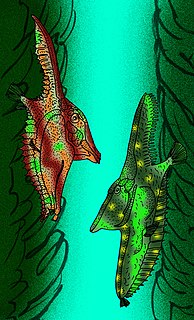 W
WGebrayelichthyidae is a family of extinct pycnodontid fish, with a superficially shrimpfish-like appearance that lived during the lower Cenomanian.
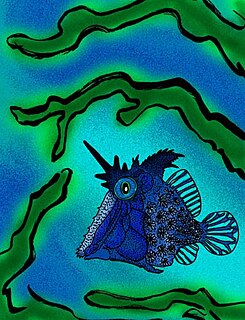 W
WIchthyoceros spinosus is an extinct pycnodontid that lived during the lower Cenomanian of what is now Lebanon. I. spinosus had a triple, forward-pointing horn-like spine between its eyes, very similar to the single spine of Trewavasia, and a massive, multipointed spine emanating from the back of its head. It was originally placed in the family Coccodontidae, but then was transferred to "Trewavasiidae" with Trewavasia. Recently, it has been placed in Gladiopycnodontidae due to recent anatomical similarities with the various genera within that family, including Gladiopycnodus.
 W
WIonoscopus is an extinct genus of prehistoric ray-finned fish.
 W
WIschyodus is an extinct genus of cartilaginous fish belonging to the subclass Holocephali, which includes the modern-day chimaeras. Fossils are known from Europe, North America, and New Zealand.
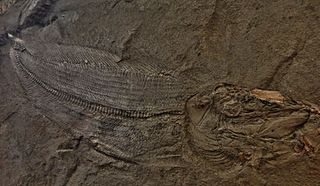 W
WIstieus is an extinct genus of prehistoric bony fish that lived from the Santonian to the Campanian.
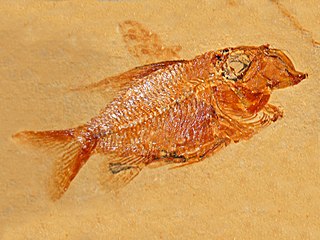 W
WLissoberyx is an extinct genus of prehistoric ray-finned fish belongon to the family Trachichthyidae. Lissoberyx is a trachichthyid, but it shows more resemblance to the holocentrids than any other trachichthyid.
 W
WMacropomoides is an extinct genus of lobe-finned fish which lived during the Cretaceous period.
 W
WMawsonia is an extinct genus of prehistoric coelacanth fish, and the largest of this group, ranging from an estimated 3.5 metres up to 6.3 metres long. It lived during the Cretaceous period. Fossils have been found in the Bahia Group, Romualdo, Alcântara and Missão Velha Formations of Brazil, South America, as well as the Continental Intercalaire of Algeria and Tunisia, the Ain el Guettar Formation of Tunisia, and the Babouri Figuil Basin of Cameroon, Africa. Mawsonia was first described by British palaeontology Arthur Smith Woodward in 1907. The type species is Mawsonia gigas, named and described in 1907. Numerous distinct species have been described since then. M. brasiliensis, M. libyca, M. minor, and M. ubangiensis have all been proposed to be synonyms of M. gigas, although Léo Fragoso's 2014 thesis on mawsoniids finds M. brasiliensis valid and cautions against synonymizing M. minor without further examination. Several recent publications consider M. brasiliensis to be valid as well. Although initially considered to belong to this genus, "Mawsonia" lavocati is most likely referable to Axelrodichthys instead.
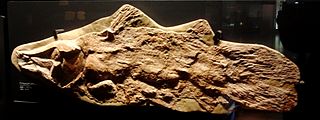 W
WMawsoniidae is an extinct family of prehistoric coelacanth fishes which lived during the Triassic to Cretaceous period.
 W
WMegalocoelacanthus dobiei is an extinct species of giant latimeriid coelacanth lobe-finned fish which lived during the Lower Campanian epoch until possibly the early Maastrichtian in the Late Cretaceous period in Appalachia, the Western Interior Seaway and Mississippi Embayment. Its disarticulated remains have been recovered from the Eutaw Formation, Mooreville Chalk Formation, and Blufftown Formation of Alabama, Mississippi, and Georgia, and also from the Niobrara Formation of Kansas. Although no complete skeleton is known, careful examination of skeletal elements demonstrate it is closely related to the Jurassic-aged coelacanthid Libys. The species is named for herpetologist James L. Dobie. It has been estimated to have been 3.5—4.5 meters in length.
 W
WNotelops is an extinct genus of prehistoric ray-finned fish.
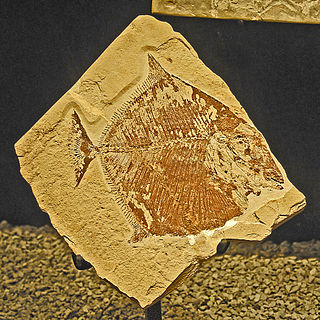 W
WPalaeobalistum is an extinct genus of prehistoric ray-finned fish which ranged from the Cretaceous to Eocene periods.
 W
WPalaeobalistum goedeli is an extinct species of prehistoric ray-finned fish that lived during the Cretaceous period.
 W
WPharmacichthys is a genus of prehistoric, deepbodied fish that was described by Woodward in 1942. Species of Pharmacichthys are known only from marine strata of Cenomanian Lebanon.
 W
WTrewavasia carinata is an extinct pycnodontid fish in the family Coccodontidae that lived during the lower Cenomanian of what is now Lebanon. It had a large, forward-pointing horn-like spine between its eyes, and a massive stump-like spine emanating from the back of its head. T. carinata is closely related the genera Corusichthys and Hensodon, as well as Coccodus.